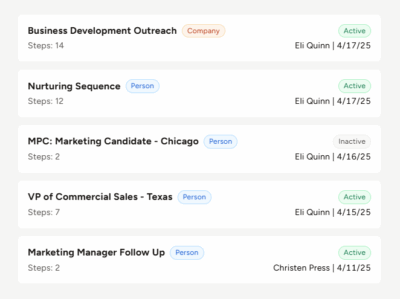Sourcing candidates is a lot of work. And, the best candidates won’t necessarily end up in your recruiting database. Sometimes, you have to put more work into searching for candidates. But, where can you find a lot of people to source candidates from? Social media.
Social media recruiting can be a beneficial addition to your candidate sourcing strategies. Find out why and how to use social media for recruiting.
The benefits of using social media for recruiting
Social media is a useful way to recruit passive candidates. There are a lot of people on social media, 78% of the U.S. population to be exact. Some of those people could be the candidates you are looking for even if they aren’t actively looking for a job. When you use social media for recruitment, you can reach out and create relationships with people you want to add to your candidate pool.
Recruiting on social media allows you to learn about a potential candidate before you reach out to them. You can see their interests, passions, and hobbies. You can gauge whether or not a person will be a good cultural fit for an open position. When you use social media for recruitment, you can decide if a person is worth your time before you begin the time-consuming recruitment process of reaching out and adding them to your pool.
Social media is free, which is one of the best benefits of using social media for recruiting. You do not have to pay to interact with people or post job openings. Of course, there are additional social media recruiting tools you can pay for, such as promoting posts so more people see them, but these things are optional.
The sites to include in your social media recruiting strategy
The social media sites you use might depend on which recruiting industry vertical you operate in. You want to be where your potential candidates are, so research what social media sites they primarily use. You ask your current candidates what social media site they use. You can also look at how active the industries you recruit for are on social media.
For many recruiters, LinkedIn is a useful website. LinkedIn is meant for professional purposes, so people have their previous work history, education, and skills listed on their profile. When you find a potential candidate, it’s like you have their resume without actually having a formal resume.
Facebook recruiting can be useful, too. Many people have their work and educational history on the site. People also join groups for professional reasons and personal interests.
Facebook might allow you to get to know a candidate beyond their work experience. People typically use Facebook to connect with friends and family. Because of this, there might be more barriers to contact people than there are on LinkedIn.
Twitter is a more open network, meaning people aren’t mainly on it for one purpose. The openness makes it easy for you to reach out to people. Recruiting on Twitter might allow you to judge the possible cultural fit of candidates because Twitter users are often open about their interests.
Other sites
Don’t forget about less common social media sites. Depending on who you are trying to recruit, smaller websites might be more useful to you. For example, StackOverflow might be useful if you are trying to recruit developers.
4 tips for recruiting using social media
The exact social media recruiting strategy you use depends on which social platform you try to recruit on. But no matter what sites you use, there are some basic things that can improve your social media recruiting success.
1. Don’t be idle
Regularly post and interact on your social media accounts. While your main purpose is to find candidates, do not let your accounts go idle between searches. You want to appear likable and approachable. By having consistent social media activity, you will seem like a real person that people want to interact with.
2. Join the conversation
Engage with people on social media. This should be the cornerstone of your social recruiting strategy. You want to find where potential candidates are at and be a part of their conversations there. Join professional and interest groups. Participate in groups of job seekers. Follow hashtags. Read and comment on what people are talking about. By interacting with social media users, people will be more willing to talk to you.
3. Encourage shares
You want as many people as possible to see the jobs you post on social media. To achieve that, you need people to share your posts. This is why creating relationships on social media is so important.
People who have a relationship with you are more likely to share your posts. You can also encourage people to share your posts. Ask people to share your posts with all their followers or with a specific person who might be interested in the position.
4. Optimize for mobile
Most people view their social media accounts on mobile devices. So when someone clicks on one of your job postings, the website or application you send them to should also be mobile friendly. If people find your recruitment website design difficult to use on their mobile devices, they might leave without giving you their information.
Once you attract a candidate, add them to Big Biller Recruiting Software. You can track your candidate as they go through your process. Free support and training is available, making the software easy to use.








